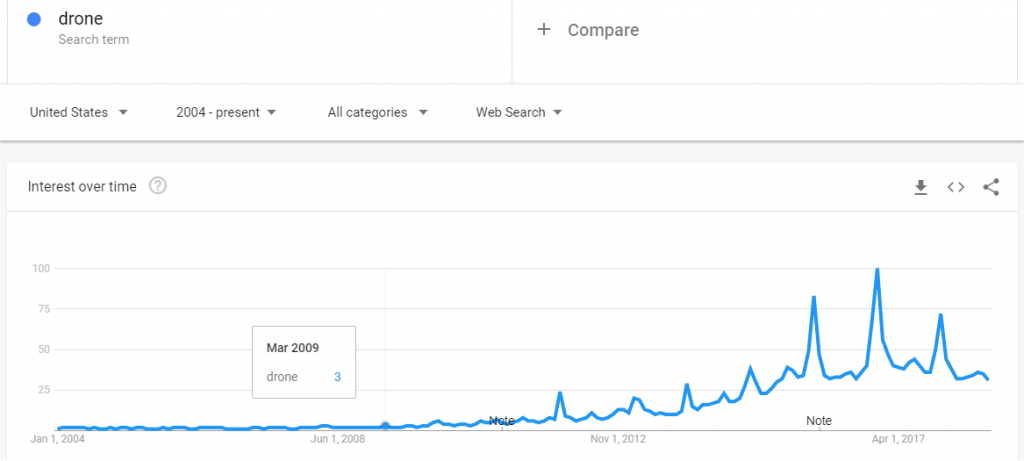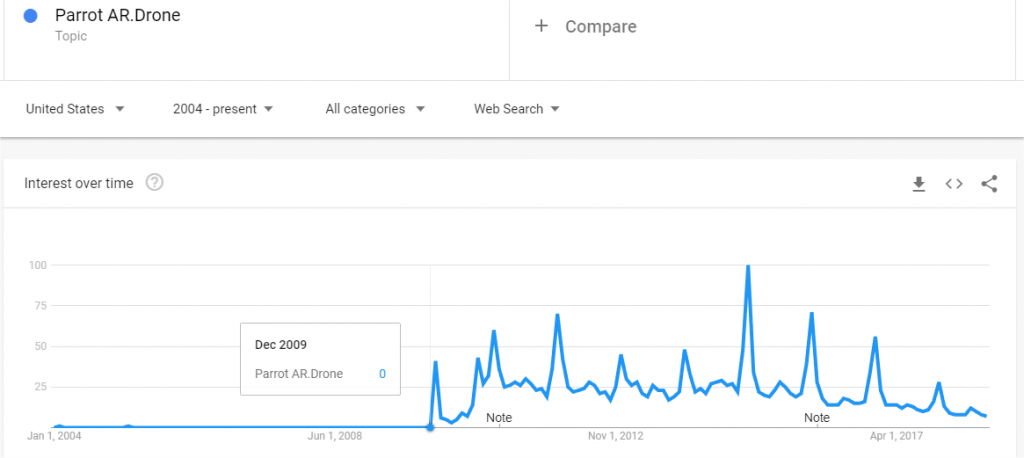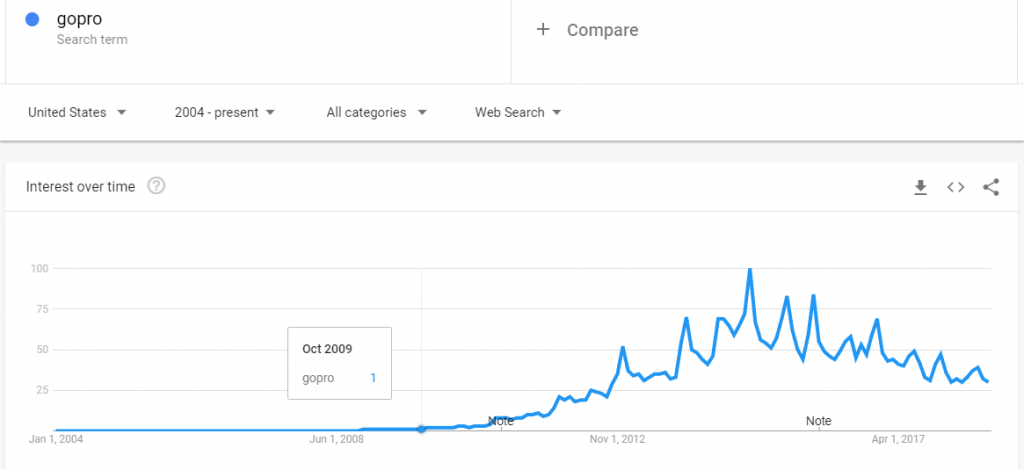Think about the product category called “drones”. There was a time in pre-2009 when consumer drones (as we know them today) pretty much did not exist. Then drones charged onto the scene and subsequently became a popular and very diverse product category. Today you can find little toy drones for $30 or less:
 All the way up to drones with payload capacities of 100+ pounds that cost tens of thousands of dollars:
All the way up to drones with payload capacities of 100+ pounds that cost tens of thousands of dollars:
 And the idea of an “affordable” taxi drone that can carry people is going to arrive any day now.
And the idea of an “affordable” taxi drone that can carry people is going to arrive any day now.
You can see the rise of drones by looking at Google Trends. No one was talking about drones or searching for them until 2009 or so, and then the popularity of the term takes off. Note that every major spike on Google Trends happens in December, presumably because of the Christmas shopping season:
 One of the first popular consumer drones was the Parrot A.R. drone, released by Brookstone (and featured on the catalog cover) for the 2009 Christmas shopping season:
One of the first popular consumer drones was the Parrot A.R. drone, released by Brookstone (and featured on the catalog cover) for the 2009 Christmas shopping season:
 So… what caused drones to spring out of nowhere and then become so popular? Drones appeared because:
So… what caused drones to spring out of nowhere and then become so popular? Drones appeared because:
- A set of technological innovations occurred…
- And then someone put these technologies together with some clever software…
- And then people really liked drones!
The technologies included:
- Neodymium magnet motors (https://en.wikipedia.org/wiki/Neodymium_magnet)
- Small, lightweight, solid-state motor controllers
- Lightweight, powerful lithium polymer battery packs
- Inexpensive 2.4 Ghz spread spectrum R/C controllers (although the Parrot drone used wifi instead. Advantage: control from an iPad and the ability to transmit video back to the tablet via wifi. Disadvantage: range of only 100 or so feet)
- Small, light, fast, low-power embedded processor chips
- Inexpensive, tiny gyro/accelerometer chips
- The software necessary to create stable flight
Until all of these things came together, drones were impossible. For example, without Neodymium magnet motors, motors are underpowered and too heavy for drones. Without lithium polymer batteries, batteries are too heavy for drones. Without cheap and tiny gyro/accelerometer chips, there is no way to stabilize the drone. And so on.
Also note that two other technologies make drones even cooler:
- Small, inexpensive GPS receiver chips
- Small, inexpensive 4K cameras and gimbal systems
These enable a rather amazing set of drones at the ~$1,000 to $2,000 price point, such as the DJI Phantom series.
All of these technologies, along with the power of creative entrepreneurship, combined together to create the drone marketplace that we see today. It is an amazing example that shows how technological advancement can enable new inventions and new product categories.
You are an entrepreneur, and you can do ideation around new/innovative combinations of technologies:
- Simply look at the different pieces of technology available to you and try to combine them together in new ways.
- Or pick a problem, and ideate on different ways to solve it with new technologies.
- Or pick an existing product, and think about how you can enhance or leapfrog it by adding cutting-edge technologies.
Let me give you several examples of products that, like drones, materialized once the enabling technologies appeared on the marketplace. Use these as inspiration for your own ideation sessions…
TV Remote Controls
There once was a time when TVs and other consumer electronic devices did not have remote controls. Then 4 things came together to make them ubiquitous:
- Infrared LEDs
- Infrared receiver chips
- Small, dedicated processor chips to encode different light pulse sequences
- Inexpensive keypads
The components of a TV remote control now cost pennies. This is why, on a lot of the toy drones that you see in the marketplace, they are controlled not by “radio control” (typically 2.4 GHz spread spectrum), but instead by “infrared control”. Infrared is strictly line-of-sight, and it has a very limited range. On a toy that is flying in your living room, however, this is fine. The use of infrared helps to keep the cost low.
Fitbit
Or think about the Fitbit. It didn’t exist, and then it stormed the market. Why? Because a set of technologies came together:
- Tiny accelerometer/gyro chips
- Tiny but powerful processor chips
- Tiny, low-power displays
- Tiny lithium polymer batteries and charging circuits
- An app to download and display the data
Put them all together in a small, sleek package and you have a Fitbit. Then they added the LED pulse-monitoring system and other innovations into the same kind of form factor. See teardown videos like this if you want to look inside a Fitbit:
The Fitbit first started making waves on Google around October 2011:
 GoPro
GoPro
The GoPro followed a similar path.
- High-resolution camera chip
- Fast, powerful CPU chip that is easy on the battery
- Small display
- Lithium polymer battery
- Interface to smart phone
- Waterproof case

Segway
The Segway came about the same way, by marrying these technologies together:
- Neodymium magnet motors (https://en.wikipedia.org/wiki/Neodymium_magnet)
- Small, lightweight, solid-state motor controllers
- Lightweight, powerful lithium polymer batteries
- On-board processor
- Clever software to do the self-balancing
Dor
You may have heard of a PIR sensor. This is the inexpensive sensor that goes inside things like motion-detecting security lights. A company called Dor in Durham (http://machinethatmakesmoney.com/designing-a-1-billion-startup/) uses a PIR sensor to count people coming into a leaving a store. Michael Brand, the CEO, hopes to create a $1 billion exit on this simple piece of technology.
Tesla Autopilot
The Autopilot capability on a Tesla automobile is made possible by a set of off-the-shelf technologies combined together to let the car drive itself. See https://www.tesla.com/autopilot for details:
“Eight surround cameras provide 360 degrees of visibility around the car at up to 250 meters of range. Twelve updated ultrasonic sensors complement this vision, allowing for detection of both hard and soft objects at nearly twice the distance of the prior system. A forward-facing radar with enhanced processing provides additional data about the world on a redundant wavelength that is able to see through heavy rain, fog, dust and even the car ahead.”
All of these pieces of technology combine with software running on a powerful on-board computer to create a system that car drive a car automatically. You can learn more about the computer here:
Smart Phones
These parts come together to create a modern smartphone like the iPhone or an Android phone:
- Nice LCD and OLED displays
- Capacitive touch overlay
- CPU/GPU chips
- Small SSD chips to create 16 to 128 GB of storage
- Nice camera chips
- High-capacity (and thin) lithium polymer batteries and charging circuits
- Cell phone radio hardware and antennas
- Accelerometer/Gyroscope chip
- GPS chip
- Bluetooth chip
- Wifi chip
- Headphone jack
- Speaker and amp
- Some sort of tactile feedback or buzzing (in iPhones it is called the “Taptic engine” (https://appleinsider.com/articles/16/09/27/inside-the-iphone-7-apples-taptic-engine-explained)
- Fingerprint sensor
If you have never looked inside a modern smartphone, a teardown video like this can be educational:
Invisible fence
These parts create an “invisible fence” for a dog:
- Radio transmitter
- Long wire
- Radio receiver (on collar)
- Shock module (on collar)
Tile
The famous Tile device (https://www.thetileapp.com) is made of:
- Bluetooth low energy transceiver chip
- Small processor
- Coin battery
- Smartphone app
Echo Dot
Inside the Echo Dot is pretty simple:
- Voice recognition like Siri (in the cloud)
- Small processor to interface to the cloud
- Microphone
- Speaker
- WiFi chip
Cameras
Dropcam, Ring doorbell camera, Dashcams and hunting cams are all similar and combine:
- Small camera
- Microphone
- Processor
- Wifi or SSD chip
Door locks
Internet-enabled door locks combine:
- Processor
- Wifi chip
- Small motor
- Battery
- An app to control the lock
If you combine a camera and a door lock you get Amazon Key delivery, where Amazon drivers will let themselves into your house to deliver packages (https://www.amazon.com/b?node=17735409011).
Remote sensing
Many different kinds of remote sensors are now possible by combining:
- Cell phone IoT module (e.g. https://hologram.io)
- Small low-power processor
- Battery
- Solar cells
- Some kind of sensor (so many types of sensors are now available. See a page like https://www.adafruit.com/category/35, and this is the tip of the iceberg)
- An app or website to see the data
We are practically at the point of creating an artificial external pancreas for diabetics by combining:
- IoT-enabled blood glucose sensing technology
- Programmable IoT-enabled insulin pumps
Here are a number of technological pieces to ponder/consider:
- Virtual reality
- Augmented reality
- Facial recognition
- IoT
- Machine learning (including neural engines, Tensorflow, cloud-enabled ML backends, etc.)
- Optical character recognition
- Mapping capabilities (Google maps, Open Street Maps, etc.)
- RFID tags (both active and passive)
- NFC
- QR codes
- Remote keyless entry for cars and houses
- Internet hotspots
- Tethering
- Radar modules
- Ultrasound modules
- Radar detectors
- Lasers (a hundred uses)
- ARM processor chips
- Smell or chemical sensors for many different chemicals
- SD memory cards and small SSD chips
- And so on…